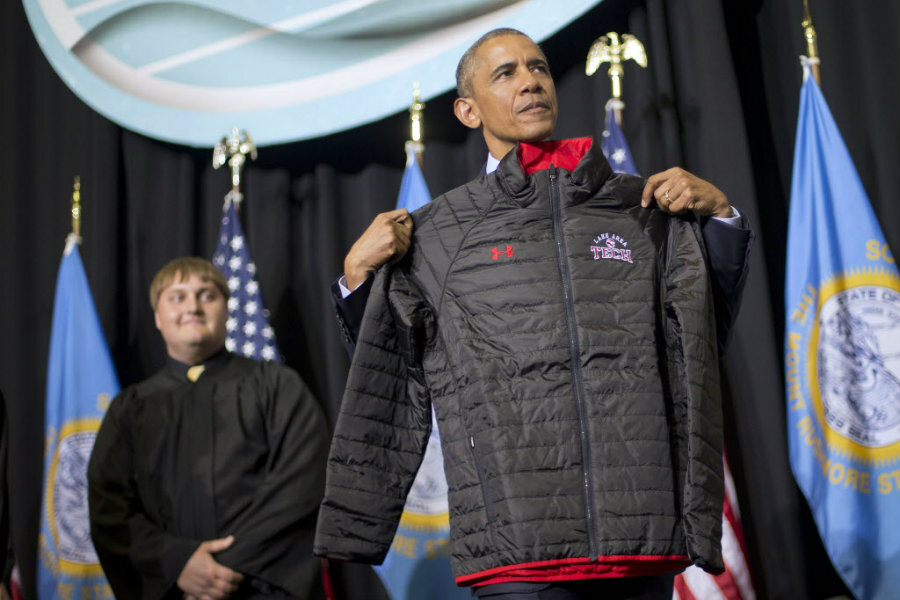Obama visits all 50 states: Does it matter?
Loading...
It’s official: Barack Obama has visited all 50 states.
The president’s trip to South Dakota Friday made him only the fourth commander-in-chief to complete the nationwide circuit after Richard Nixon, George H.W. Bush, and Bill Clinton. It’s a tour that may appear to be an empty gesture, especially when done towards the end of a president’s final term. But some say the trip is an important duty for an incumbent leader, particularly when a country is experiencing political, social, and economic divides.
“Every president should be willing to offer an end-of-term olive branch," Kelsey Rupp, a Collegiate Network fellow for USA Today's editorial board, wrote in a May 8 op-ed. "There is a little goodness in the grudging acknowledgement that people in your opposition's smallest strongholds are just being Americans."
“In a time of increasing vitriol and partisanship, that reminder can only be a good thing,” she added.
President Obama’s visit to South Dakota may provide some evidence that a personal gesture may serve to soften hardened feelings. Politically, the state hasn’t shown the president much love: In 2008, Obama lost South Dakota to Hillary Clinton in the Democratic primary, and went on to lose the state in both subsequent general presidential elections.
The relationship deteriorated further last June, when the state’s Republican Party passed a resolution calling for Obama’s impeachment, saying that he “violated his oath of office in numerous ways,” according to the Argus Leader.
Yet when the president arrived Friday to deliver the commencement address at Lake Area Technical Institute in Watertown, S.D., residents lined the route from the airport to the local high school, “some looking as if they'd camped out for hours and others holding welcome signs,” the LA Times reported. The state’s all-Republican congressional delegation, including Gov. Dennis Daugaard, made an appearance, as well.
“The president’s visit puts a national spotlight on one of the nation’s best technical colleges, and we are pleased to welcome him,” Gov. Daugaard told Politico.
Obama returned the courtesy during his speech at Lake Area Tech, where he spoke to a capacity crowd, according to The New York Times.
“I have now been to all 50 states as president – and I was saving the best for last,” he said. “To the other 49, I hope you take no offense.”
Obama also took the opportunity to promote his proposal for a tuition-free community college education, which he unveiled in January. The plan, which comes with a $60 billion budget, would require states to support higher education institutions that offer two-year degrees, and ensure that those degrees are more easily transferrable to four-year colleges. The proposal needs support from Congress, and South Dakota lawmakers have not said whether or not they are willing to participate, the Argus Leader reported.
"Community colleges like this one can be a great place for young people to launch a career," Obama said. "But they're also a great place for folks who have been in the workforce for a while."
"I want to lower the cost of community college in America to zero," he said to applause, according to the Argus Leader.
Before he left, Obama stopped to chat with Rebecca Kelley, an 11-year-old South Dakota resident who sent him a letter asking him to visit her state.
“There’s really no words to describe the feeling,” Ms. Kelley told USA Today.
Success or not, it’s unlikely that the president’s South Dakota trip will make a dent in his approval ratings in that state – among the lowest in the nation as of 2014, at about 32 percent – or any other. Nor will it likely do much to ease partisan tensions among red- and blue-state delegations in Congress. But it might be beneficial to the president's understanding of American voters.
“[W]hy shouldn't a sitting president visit every corner of the country he's leading, even where he's unpopular?” Ms. Rupp asked. “A little face time with citizens both hot and cold to a president's politics can, at the very least, remind him that within our country's borders lie lands far different from each other.”
“It is a reminder that is too infrequent,” she added.








